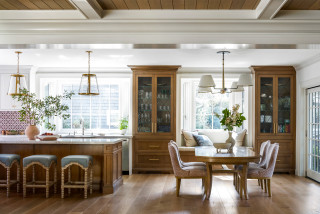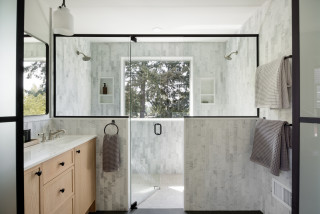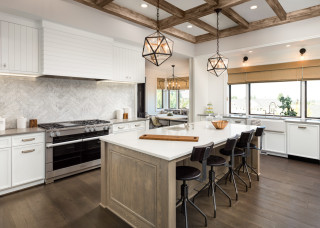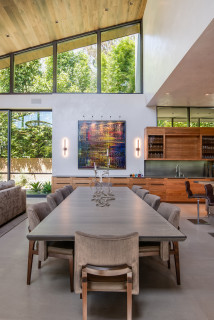
This article was originally published by a www.houzz.com . Read the Original article here. .

Adding to or remodeling your house is one of the most exciting and creative processes you can go through. But with all that responsibility comes pressure to make informed decisions that will last. How can you make sure to get the right design for your lifestyle, stay within your budget and maximize the return on your investment? Start with a great design for every room in your house — including (or especially) the bathroom.
Bathrooms, whether big or small, should always be well thought out and carefully located, and should function with multiple users in mind. We’re long past the era where there was one bathroom for every three bedrooms in the house, and everyone had all the time needed to use it. Today’s bathrooms need to be beautiful, use space efficiently and serve the users functionally. Avoiding common design blunders, as these rooms nicely do, can help you be happier with your bathroom for the long haul.
No one likes a dark, damp bathroom with bad circulation — it’s no fun spending time in a space like that. If you’re building or relocating a bathroom, try to site it on an outside wall with windows.
Find a bathroom designer near you
If windows are not an option, installing an operable skylight can allow for the fresh air and natural light needed to make the space feel comfortable.
I once worked on a large remodel for which the existing design had a bathroom in the dining room — seems kind of like a conflict of interests, right? Whenever possible, avoid locating the bathroom directly off one of the home’s public rooms — like the kitchen, living room or dining room.
This doesn’t necessarily mean you have to put in a long hallway, but create some sort of formal separation to break up the line of sight. The last thing you want is to be sitting in the living room with a glass of wine and looking straight into the bathroom at the toilet.
Shop for bathroom vanities on Houzz
That leads me to my next blunder: Avoid making the toilet the first thing you see in the bathroom, and avoid any sightlines to it from adjacent rooms. I like to put the toilet and shower in their own room while keeping the sink separate. This allows someone to take a shower while someone else gets ready at the sink.
Not sure where to start on your home project? Learn the basics
In the bathroom floor plan here, the wall between the two rooms adds only a couple of inches to the overall size of the bathroom but doubles the room’s functionality.
Shop for bathroom accessories
That’s right: Bigger isn’t better; better is better. Whether you’re designing a large master bathroom in your dream home or trying to figure out how to squeeze in an extra bathroom for your growing family, the most important aspect of your new bathroom is that it has a great design that functions efficiently for your specific lifestyle.
Tell us: Have you had any bathroom remodeling blunders or successes? Share your experiences in the Comments.
More on Houzz
Read more stories about bathroom design
Find a bathroom remodeler
Shop for bathroom products
This article was originally published by a www.houzz.com . Read the Original article here. .

When planning your remodel, make sure you put your kitchen’s busiest areas — the sink, stove and fridge — in practical locations that are relevant to one another while allowing enough space for people to use and access them comfortably, Findlay says.
When choosing cabinetry, make sure the doors won’t block your workflow when they’re open, she says. “The last thing you want is your fridge and cupboard doors banging into each other every time you open them!”
Solution: Plan your kitchen layout as far in advance as possible, and choose your appliances before you start looking at cabinetry, Findlay says. “This will allow you to fit your units around your appliances, rather than the other way around, giving you a seamless look that’s both smart and space-efficient.”
Tip: Think about how many people live in your home and will be using the kitchen at one time, she says. If it’s going to get crowded, you may have crammed too many elements into the kitchen layout and may want to consider scaling back.
This article was originally published by a www.houzz.com . Read the Original article here. .

“Many clients understandably don’t want a high-maintenance [yard] and this seems to manifest in them asking for narrow flower beds, as these will require less work — right?” Reader says. “Actually, this is wrong.”
Solution: Use shrubs. “The best low-maintenance plants are shrubs,” Reader says. “They last many years, don’t require a lot of looking after and can deliver interesting structure, flowers, berries and autumn leaf color — and many of them are evergreen, so look good in winter too.
“The thing about shrubs, though, is many of them will get quite big,” he continues. “So if you put them in a narrow bed, you’ll fairly quickly be having to cut them back frequently, as they’ll overhang the lawn or paths. This destroys the beauty of their natural shape, creates woody holes in the foliage canopy and creates maintenance.
“By having a wider bed to start with, the shrubs can be gently pruned as they reach their mature size every three to five years and be kept looking beautiful,” he says.
This article was originally published by a www.houzz.com . Read the Original article here. .

Budget can be a major cause of problems during a project, particularly when initial costs increase during the process.
Solution: “It’s best to ask clients for their budget, so you can work around that,” says Saimir Zejneli of The Home Refurbishment Co. He believes this is the best way to avoid wasting time or causing problems later on.
“It’s easy to get into a dispute with clients if the [finish work] is included in the quote, as clients are likely to choose more expensive products,” Zejneli adds.
He recommends setting a budget for just the roughing in. For example, a kitchen budget might include supply of the kitchen cabinets, electrical and plumbing, but the client would choose items such as appliances, faucets, sinks and tile.
“You can give clients the links of traders you have accounts with to get a discount, but when they’re able to decide on their own [finish] materials, they’re in control of their budget,” he says.
This article was originally published by a www.houzz.com . Read the Original article here. .
If you’re going to take the time to photograph your projects, make sure everything is covered. If only one part of a room is visible, for example, the project won’t be seen in its entirety.
Solution: Provide a comprehensive shoot list for your photographer to ensure they snap everything you want to showcase. Consider, too, whether you’d like your project to be featured editorially, as there are often some minimum requirements. On Houzz, for instance, an article about a full house or condo project requires, at minimum, images of the kitchen, living area, a bedroom and a bathroom. A room tour on Houzz requires multiple photos of the space.
Find a professional photographer near you